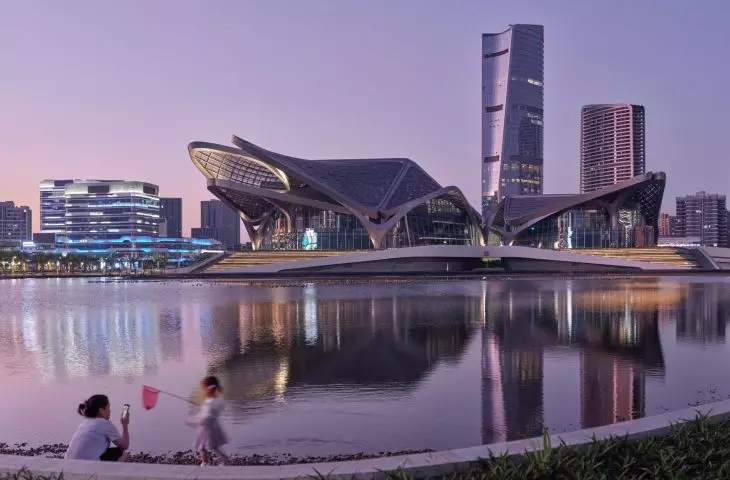Zhuhai Municipal Art Center,
designed by Zaha Hadid Architects
The Municipal Art Center, designed by the Zaha Hadid Architects studio, opened in December 2023 in China's Zhuhai, Jinwan district. The architectural concept is inspired by chevron (inverted "V") patterns, which symbolize the wings of migratory birds flying over southern China.
A modern center for arts
and science in the heart of Jinwan
The Zhuhai Art Center is an innovative cultural and educational complex located in one of the world's fastest growing regions. Situated in the heart of Jinwan District, it is an integral part of the new urbanization of Aviation City, covering an area of 4.78 million sq. m. used by more than 100,000 residents. The complex harmoniously combines cultural, educational and commercial functions, and its prime location provides easy access to downtown Zhuhai and the airport.
The Zhuhai Art Center integrates three independent cultural institutions
©CAT-OPTOGRAM STUDIO
three cultural institutions in one place
The center integrates three major institutions: The Performing Arts Center, with a large theater with 1,200 seats and a flexible "Black Box" space with 500 seats; the Science Center, offering interactive exhibitions; and the Art Museum. At 170 meters wide and 270 meters long, this complex is one of the largest of its kind in the region.
Zhuhai Art Center
©CAT-OPTOGRAM STUDIO
An island of culture
with a harmonious spatial layout
The center is located on an island within the artificial ZhongXin Lake, connecting to the surrounding area through a system of ramps and pedestrian tunnels. The buildings of the complex are arranged symmetrically around the main axis, creating a composition reminiscent of the outspread wings of a butterfly. The two larger buildings on either side of the central plaza interact with the smaller buildings to create a cohesive cultural space.
The Zhuhai Art Center features a symmetrical layout that resembles the outstretched wings of a butterfly
©Zaha Hadid Architects
an architectural metaphor for flight
The roofs of all buildings are undulating, openwork structures that resemble the wings of migrating birds. Prefabricated steel panels in the shape of chevrons, varying in size and angle of inclination, were used, emphasizing the dynamic character of the buildings. The organic, rounded forms give the masses lightness and fluidity.
The roofs of the Zhuhai Art Center's buildings allude to the wing pattern of migrating birds
©Virgile Simon Bertrand
public space with a view
of the city and nature
The main square is a multi-level public space with bridges, columns and open spaces that offer views of the buildings' interiors and surrounding promenades. Glazed facades let in natural light, and the space is enlivened by white and black surfaces.
The main plaza of the Zhuhai Art Center creates a multi-level public space with a dynamic layout
©Virgile Simon Bertrand
A similar contrast can be seen in the interiors: bright colors dominate the Grand Theatre and the Art Museum, while darker finishes were used in the "Black Box" Theater and the Science Center.
Inside the Zhuhai Art Center, there are numerous bridges and columns, creating dynamic, multi-level arrangements. - The spaces are dominated by a contrasting color scheme - bright, white surfaces are interspersed with dark, black zones
©Virgile Simon Bertrand
theater with excellent acoustics
The Grand Theatre is characterized by ceiling panels that act as sound reflectors, providing excellent acoustic conditions.
Zhuhai Art Center - The interior of the Grand Theatre continues the idea of an openwork roof
©Seilao Jiong
The materials used meet the highest standards, enabling local and international performances.
Zhuhai Art Center - interior of the "Black Box" theater.
©Seilao Jiong
exhibition and educational spaces
The glass atrium of the Art Museum fills the interiors with natural light, and a white "ribbon" wrapping around the building marks the main exhibition route, connecting the museum's various zones. This approach to the design of exhibition spaces allows seamless movement between different sections.
Zhuhai Art Center - Natural light streaming in through the glass facades creates a welcoming atmosphere
©Virgile Simon Bertrand
the island as a small "sponge city"
The space around ZhongXin Lake was designed as part of an urban rainwater harvesting system, which promotes natural filtration and allows up to 70% of rainfall to be reused. The system is an example of a sustainable approach to the design of urban public spaces.
The Zhuhai Art Center was located on an island within an artificial lake called ZhongXin
©CAT-OPTOGRAM STUDIO
advanced building technologies
The building facades consist of double-insulated glazing, which provides excellent thermal performance and protects interiors from excessive heat. Openwork aluminum panels in the roof act as sunscreens, with perforations precisely tailored to the needs of individual spaces.
A bird's-eye view of the Zhuhai Art Center
©Yipeng Lyu
innovative energy management
Systems for monitoring air quality and energy consumption automatically adjust indoor conditions to meet users' needs. Thermal waste is used to heat water, and irrigation systems based on soil moisture sensors allow significant water savings.
The architectural concept of the Zhuhai Municipal Art Center is inspired by chevron patterns
©Virgile Simon Bertrand
recycling and sustainable materials
The center was built using recycled materials such as steel and aggregate, which minimizes the environmental impact of construction and promotes the principles of a closed-loop economy. The entire construction is based on green solutions that make this project a model of sustainable construction.
Zhuhai Art Center - north and west elevations
©Zaha Hadid Architects
The Zhuhai Art Center is a modern example of harmony between aesthetics, functionality and environmental responsibility. It is a project that sets new standards for contemporary public architecture in China.
Elaborated: Anastazja Dżupina
Illustrations provided courtesy of Zaha Hadid Architects.







































































































